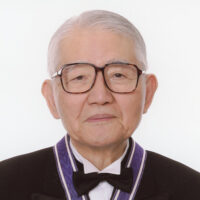
2007 Kyoto Prize Laureates
Materials Science and Engineering
/ Chemist
1927 - 2014
Professor Emeritus, The University of Tokyo and Institute for Molecular Science/National Institutes of Natural Sciences
My Journey in Chemical Research—Learning from People and Things
2007
11 /11 Sun
Place:Kyoto International Conference Center
New Developments in Organic Semiconductors and Conductors
2007
11 /12 Mon
13:00 - 17:10
Place:Kyoto International Conference Center
Dr. Hiroo Inokuchi initiated pioneering research on electrical conduction between molecules with benzene rings and established the scientific foundation for studying the electrical conductivity of organic materials. Further, he systematically elucidated an electronic structure of a wide variety of organic materials by photoelectron spectroscopy. Through a series of such studies, he established the academic base essential for studying the electronic properties, making fundamental contributions to the subsequent development of organic molecular electronics.
Dr. Hiroo Inokuchi focused his attention on organic molecules consisting of benzene rings in the late 1940s and started pioneering research on electrical conduction between molecules, discovering that they exhibit semiconducting properties. Further, he established the scientific foundation for studying the electrical conductivity of organic materials through his discovery that the addition of an electron-accepting substance to organic molecules dramatically increases electrical conductivity, making them an organic conductor. Moreover, Dr. Inokuchi systematically elucidated the electronic structure of a wide variety of organic materials by photoelectron spectroscopy. Through a series of such studies, Dr. Inokuchi established the scientific foundation essential for understanding and utilizing the electronic properties and functions of organic materials, making fundamental contributions to the subsequent development of organic molecular electronics.
Around 1950, Dr. Inokuchi, jointly with Dr. Hideo Akamatu, conducted groundbreaking studies that systematically investigated the intermolecular electrical conductivity of an organic molecule called violanthrone consisting of nine benzene rings, and found that this organic material is capable of acting like a semiconductor in a manner similar to inorganic materials. In addition, he discovered jointly with Dr. Akamatu and Dr. Yoshio Matsunaga that the addition of an electron-accepting substance such as bromine or iodine to an organic material such as perylene causes transfer of electrons between the two components and forms charge-transfer complexes with high charge density, thereby increasing electrical conductivity significantly. These pioneering studies triggered major advances in the science of organic conductors in the following 50 years, helping to establish a technological basis for the practical utilization of organic conductors. Dr. Inokuchi continued with systematic studies of photoelectron spectroscopy to elucidate the electronic structures of organic materials, determining the ionization energies of a large number of organic materials. The findings of this research played a critical role in the design and creation of organic electroluminescent (EL) devices in later years.
Dr. Inokuchi’s groundbreaking studies served as a basis not only for scientific investigations into organic conductors, which have advanced remarkably over the past fifty years, but also for the creation and development of technologies that utilize the electronic properties of organic materials, making fundamental contributions to the establishment of organic molecular electronics that includes applications to organic EL devices and organic transistors. Furthermore, Dr. Inokuchi has assisted in the development of outstanding researchers and research groups in the science and engineering fields of organic molecules and established a world-class center of excellence for the research of organic materials with electrical properties, making substantial contributions to international, academic interactions.
For these reasons, the Inamori Foundation is pleased to present the 2007 Kyoto Prize in Advanced Technology to Dr. Hiroo Inokuchi.
Profile is at the time of the award.